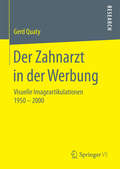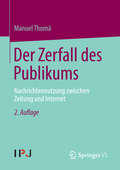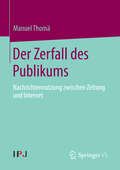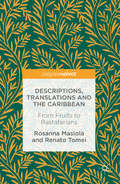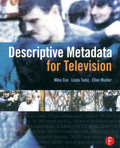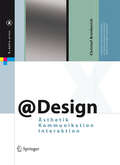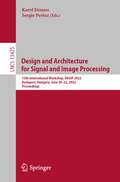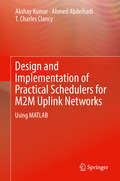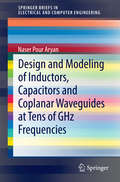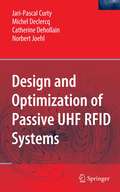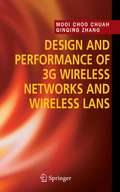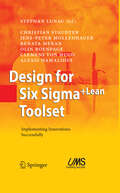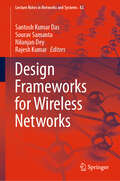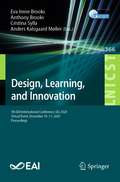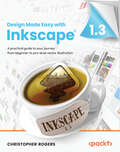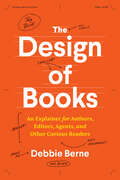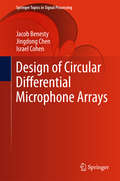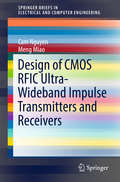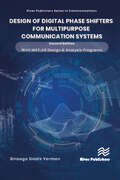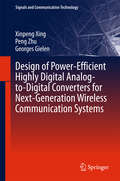- Table View
- List View
Der Zahnarzt in der Werbung: Visuelle Imageartikulationen 1950 – 2000
by Gerd QuatyGerd Quaty rekonstruiert die Imagebildung von Zahnärzten in Deutschland von 1950 bis 2000 und zeigt darüber hinaus Tendenzen bis in die Gegenwart auf. Die Entwicklung dieses Images wird anhand von visuellen und textlichen Kommunikationsmitteln in der Werbung aufgezeigt. Der Autor legt dar, welche Elemente zum Profil des „Gottes in Weiß“ gehören und wie sie dieses Bild prägen. Seine Arbeit ist nicht nur als fachwissenschaftlicher Beitrag zur Medienpädagogik und Kommunikationswissenschaft zu sehen, sondern auch als wichtige Grundlage für die Kulturgeschichte des Ärztestandes und der Professionsgeschichte der Medizin in Deutschland seit dem Zweiten Weltkrieg.
Der Zerfall des Publikums: Nachrichtennutzung zwischen Zeitung und Internet
by Manuel ThomäE-paper, Webseite, Blog und natürlich Zeitung – Verlage vermitteln heute journalistische Informationsangebote über viele Channels. Doch wie informieren sich die Leser und User? Nur wenig ist bekannt darüber, ob für sie im Netz andere Themen Relevanz besitzen als in der Tageszeitung oder ob ein attraktiver Online-Auftritt neue Leser gewinnen und an die Zeitung heranführen kann. Manuel Thomä beschreibt, wie journalistische Informationsangebote in Printund Online-Medien genutzt werden. Er zeigt den Wandel des Nachrichtensystems zwischen Zeitung und Internet und welche Folgen er für die Medienrezeption der Leser hat. Dargestellt werden verschiedene Ansätze, die sich in der Kommunikations- und Medienforschung mit diesen Entwicklungen beschäftigen. Die empirische Basis bildet ein langjähriges Forschungsprojekt des Instituts für Praktische Journalismusforschung. Um die spezifische Nutzung einzelner Channels zu analysieren wurden 30 problemzentrierte Interviews geführt, 1.239 regelmäßige Leser telefonisch interviewt und erstmals über eine Paneluntersuchung rund 350 Leser und User periodisch online befragt. Die Ergebnisse zeigen, wie häufig und warum die befragten Leser auf einzelne Medienangebote zugreifen, wie sie diese bewerten und warum sie auf andere verzichten.
Der Zerfall des Publikums: Nachrichtennutzung zwischen Zeitung und Internet
by Manuel ThomäE-paper, Webseite, Blog und natürlich Zeitung – Verlage vermitteln heute journalistische Informationsangebote über viele Channels. Doch wie informieren sich die Leser und User? Nur wenig ist bekannt darüber, ob für sie im Netz andere Themen Relevanz besitzen als in der Tageszeitung oder ob ein attraktiver Online-Auftritt neue Leser gewinnen und an die Zeitung heranführen kann. Manuel Thomä beschreibt, wie journalistische Informationsangebote in Print- und Online-Medien genutzt werden. Er zeigt den Wandel des Nachrichtensystems zwischen Zeitung und Internet und welche Folgen er für die Medienrezeption der Leser hat. Dargestellt werden verschiedene Ansätze, die sich in der Kommunikations- und Medienforschung mit diesen Entwicklungen beschäftigen. Die empirische Basis bildet ein langjähriges Forschungsprojekt des Instituts für Praktische Journalismusforschung. Um die spezifische Nutzung einzelner Channels zu analysieren wurden 30 problemzentrierte Interviews geführt, 1.239 regelmäßige Leser telefonisch interviewt und erstmals über eine Paneluntersuchung rund 350 Leser und User periodisch online befragt. Die Ergebnisse zeigen, wie häufig und warum die befragten Leser auf einzelne Medienangebote zugreifen, wie sie diese bewerten und warum sie auf andere verzichten.
Deregulierte Telekommunikationsmärkte: Internationalisierungstendenzen, Newcomer-Dynamik, Mobilfunk- und Internetdienste (Wirtschaftswissenschaftliche Beiträge #178)
by Robert F. PelzelGrundlegende technologische und regulatorische Veränderungen haben zur Jahrtausendwende die Telekommunikationsmärkte mit erheblichem Anpassungsdruck konfrontiert. Im Mittelpunkt der hier untersuchten Problemstellung steht der Wandlungsprozeß dieses dynamischen Marktes, in dem auch eine verstärkte Ausnutzung der vorhandenen Innovationspotentiale zu beobachten ist. Dabei ist die Qualität und der Preis der Informationsübermittlung im Fest- und Mobilfunknetz zu einem determinierenden Element der Leistungsfähigkeit von Volkswirtschaften geworden. Zusätzlich verändern die technologischen Meilensteine wie Internet, E-Commerce und UMTS die "Spielregeln" für alle Marktteilnehmer in immer kürzerer Zeit. Der Vergleich der Märkte in den USA, in Großbritannien und in Deutschland zeigt dabei einige Parallelen, aber auch überraschende Unterschiede.
Descriptions, Translations and the Caribbean: From Fruits to Rastafarians
by Rosanna Masiola Renato TomeiThis book offers a new perspective on the role played by colonial descriptions and translation of Caribbean plants in representations of Caribbean culture. Through thorough examination of Caribbean phytonyms in lexicography, colonization, history, songs and translation studies, the authors argue that the Westernisation of vernacular phytonyms, while systematizing the nomenclature, blurred and erased the cultural tradition of Caribbean plants and medicinal herbs. Means of transmission and preservation of this oral culture was in the plantation songs and herb vendor songs. Musical creativity is a powerful form of resistance, as in the case of Reggae music and the rise of Rastafarians, and Bob Marley’s ‘untranslatable’ lyrics. This book will be of interest to scholars of Caribbean studies and to linguists interested in pushing the current Eurocentric boundaries of translation studies.
Descriptive Metadata for Television: An End-to-End Introduction
by Mike Cox Ellen Mulder Linda TadicDescriptive Metadata for Television is a comprehensive introduction for television professionals that need to understand metadata's purpose and technology. This easy-to-read book translates obscure technical to hands-on language understandable by real people.
Descriptive Metadata for Television: An End-to-End Introduction
by Mike Cox Ellen Mulder Linda TadicDescriptive Metadata for Television is a comprehensive introduction for television professionals that need to understand metadata's purpose and technology. This easy-to-read book translates obscure technical to hands-on language understandable by real people.
@Design: Ästhetik, Kommunikation, Interaktion (X.media.press)
by Christof BreidenichWeblogs und Web-Communities formieren sich derzeit zu Leitmedien der vernetzten Gesellschaft. Der Autor zeigt, wie deren Verständlichkeit und Handhabung erst durch Gestaltung realisiert werden. Er liefert mit Beispielen aus der Medientheorie, der Kunstwissenschaft sowie den Grundlagen der Gestaltung ein Fundament, um Kommunikation und ihre Gestaltung in interaktiven Medien zu verstehen. Kernaussagen illustriert er anhand anschaulicher Beispiele. Jeder kann zum Designer werden, wenn er versteht, wie Kommunikation in interaktiven Medien funktioniert.
Design and Architecture for Signal and Image Processing: 15th International Workshop, DASIP 2022, Budapest, Hungary, June 20–22, 2022, Proceedings (Lecture Notes in Computer Science #13425)
by Karol Desnos Sergio PertuzThis book constitutes the thoroughly refereed conference proceedings of the First International Workshop on Design and Architecture for Signal and Image Processing, DASIP 2022, held in Budaypest, Hungary in June 2022. The 13 full included in the volume were carefully reviewed and selected from 32 submissions. They are organized in the following topical sections: leading signal, image and video processing and machine learning in custom embedded, edge and cloud computing architectures and systems.
Design and Implementation of Practical Schedulers for M2M Uplink Networks: Using MATLAB
by Akshay Kumar Ahmed Abdelhadi T. Charles ClancyThis book presents the design of delay-efficient packet schedulers for heterogeneous M2M uplink traffic classified into several classes, based on packet delay requirements, payload size, arrival process, etc. Specifically, the authors use tools from queuing theory to determine the delay-optimal scheduling policy. The proposed packet schedulers are designed for a generic M2M architecture and thus equally applicable to any M2M application. Additionally, due to their low implementation complexity and excellent delay-performance, they authors show how they are also well-suited for practical M2M systems. The book pertains primarily to real-time process scheduler experts in industry/academia and graduate students whose research deals with designing Quality-of-Service-aware packet schedulers for M2M packet schedulers over existing and future cellular infrastructure. Presents queuing theoretic analysis and optimization techniques used to design proposed packet scheduling strategies;Provides utility functions to precisely model diverse delay requirements, which lends itself to formulation of utility-maximization problems for determining the delay- or utility-optimal packet scheduler;Includes detail on low implementation complexity of the proposed scheduler by using iterative and distributed optimization techniques.
Design and Implementation of Sensory Solutions for Industrial Environment: Utilizing 1-wire® Technology in Industrial Solutions (Signals and Communication Technology)
by Juraj Ďuďák Gabriel GašparThis book presents applicable guidance into sensor system hardware and software design, extensions, and integration aimed at utilization of 1-wire networks. The content is structured from the design of the sensor system architecture—hardware and software—through the implementation and optimization of the solution to the practical verification. The hardware part consists of the design of specific solutions for sensor data collection and the design and integration of standard and special sensors into these solutions. The development of the hardware solutions is focused on integration with 32-bit microcontrollers with ARM Cortex M0 to Cortex M4 cores. For the sensor solutions, the focus is on design versatility and miniaturization of dimensions with respect to the availability of the technology in the physical design. The focus is on minimizing power consumption to the design of power independent modules. The presented solution includes the design and implementation of the software layer, which includes control software for direct communication with the sensor modules as well as an information system for continuous data storage and remote access. The book presents an extensive case study that describes the design and development of a 1-wire bus controller hardware module solution with proprietary modifications that achieve improvements to the maximum 1-wire bus length. The study also includes the design and implementation of a universal and power independent 1-wire bus device. Using this module, almost any sensor can be connected to the 1-wire bus.
Design and Modeling of Inductors, Capacitors and Coplanar Waveguides at Tens of GHz Frequencies (SpringerBriefs in Electrical and Computer Engineering)
by Naser Pour AryanThis book describes the basic principles of designing and modelling inductors, MIM capacitors and coplanar waveguides at frequencies of several tens of GHz. The author explains the design and modelling of key, passive elements, such as capacitors, inductors and transmission lines that enable high frequency MEMS operating at frequencies in the orders of tens of GHz.
Design and Optimization of Passive UHF RFID Systems
by Jari-Pascal Curty Michel Declercq Catherine Dehollain Norbert JoehlRadio Frequency IDentification (RFID) stores and retrieves data using devices called RFID tags: objects attached to or incorporated into a product, animal or person which communicate with an RFID reader or interrogator. This book proposes a linear two-port model for an N-stage modified-Greinacher full wave rectifier, predicting the overall conversion efficiency at low power levels where the diodes are operating near their threshold voltage. Included is an experimental procedure to measure how impedance modulation in the tag affects the signal at the reader, and a useful tool for choosing the most appropriate impedances.
Design and Performance of 3G Wireless Networks and Wireless LANs
by Mooi Choo Chuah Qinqing ZhangPresentation of background material of wireless communications, traffic modeling and traffic engineering techniques. Provides descriptions of upcoming features such as IP multimedia subsystems, multimedia broadcast/multicast services and Push-to-Talk over Cellular (PoC) for 3G networks Including problems at the end of each chapter Written for lecturers, graduate students and system designers
Design for Six Sigma + LeanToolset: Implementing Innovations Successfully
by Christian Staudter Jens-Peter Mollenhauer Renata Meran Olin Roenpage Clemens Hugo Alexis HamalidesEvery company relies on innovation to compete globally. However, creative ideas are mostly insufficient if you want to translate an innovative spirit into commercial success. The ability to put a new product or a new process on the market as quickly as possible is becoming increasingly important. Systematic management is necessary for developing cost-effective and successful products based on market realities and customer requirements. Especially open innovation, which is currently intensively discussed and widely implemented, requires consideration. Only a sensible interface and information management is capable of generating overall success from a variety of good ideas. +Lean Design for Six Sigma is an approach for such a systematic innovation management. This concept was developed to achieve a target-oriented realization of innovations and is +Lean strongly associated with the Six Sigma methodology, currently applied globally to opti - +Lean mize existing processes. DFSS synthesizes a number of key factors, including the active integration of employees, customer-oriented development, the reduction of complexity in products and processes, and controlling of innovation in terms of a standardized procedure. The present toolset represents the proven approach UMS takes when putting Design for +Lean Six Sigma into practice. Its individual tools are assigned to the process model Define, Measure, Analyze, Design, and Verify in a clear and manageable structure. This structure can be considered as a red thread and makes it easier to apply the tools in practice and organize an innovative product and process development that is target-oriented and ef- cient.
Design Frameworks for Wireless Networks (Lecture Notes in Networks and Systems #82)
by Santosh Kumar Das Sourav Samanta Nilanjan Dey Rajesh KumarThis book provides an overview of the current state of the art in wireless networks around the globe, focusing on utilizing the latest artificial intelligence and soft computing techniques to provide design frameworks for wireless networks. These techniques play a vital role in developing a more robust algorithm suitable for the dynamic and heterogeneous environment, making the network self-managed, self-operational, and self-configurational, and efficiently reducing uncertainties and imprecise information.
Design, Learning, and Innovation: 5th EAI International Conference, DLI 2020, Virtual Event, December 10-11, 2020, Proceedings (Lecture Notes of the Institute for Computer Sciences, Social Informatics and Telecommunications Engineering #366)
by Eva Irene Brooks Anthony Brooks Cristina Sylla Anders Kalsgaard MøllerThis book constitutes the refereed post-conference proceedings the 5th EAI International Conference on DLI 2020, Design, Leaning and Innovation, which took place in December 2020. Due to COVID-19 pandemic the conference was held virtually. The 14 revised full papers presented were carefully selected from 40 submissions and are organized in four thematic sessions on: digital technologies and learning; designing for innovation; digital games, gamification and robots; designs for innovative learning.
Design Made Easy with Inkscape: A practical guide to your journey from beginner to pro-level vector illustration
by Christopher RogersWith the power and versatility of the Inkscape software, making charts, diagrams, illustrations, and UI mockups with infinite resolution becomes enjoyable. If you’re looking to get up to speed with vector illustration in no time, this comprehensive guide has got your back! Design Made Easy with Inkscape is easy to follow and teaches you everything you need to know to create graphics that you can use and reuse forever, for free! You’ll benefit from the author’s industry experience as you go over the basics of vector illustration, discovering tips and tricks for getting professional graphics done fast by leveraging Inkscape's powerful toolset. This book teaches by example, using a great variety of use cases from icons and logos to illustration, web design, and product design. You’ll learn about hotkeys and take a best-practices approach developed over ten years of using Inkscape as a design tool in production. What’s more, this book also includes links to free graphics resources that you can use in all your projects. Whether you’re a new user or a professional, by the end of this book, you’ll have full understanding of how to use Inkscape and its myriad of excellent features to make stunning graphics for your projects.Key FeaturesGet up to speed with vector illustration in no timeExplore hotkey charts and tips, with best practices developed over ten years of using InkscapeLearn the fundamentals of vector illustration and efficiently leverage Inkscape's powerful toolsetWhat you will learnUnderstand the benefits of vector illustration and the reasons behind choosing Inkscape over other non-free alternativesNavigate the Inkscape setup and workspace to make effective use of the softwareExplore the wide range of tools from Inkscape to create amazing and infinitely scalable graphics quicklyUse real-world scenarios and practice lessons to learn how to create by exampleDiscover tips and tricks to make Inkscape an extension of your creativityConvert photos to vector art and practice with professional design examples as you work with layers, shading, coloring and much moreWho this book is forThis book is for aspiring designers, developers, and anyone who wants to leverage the power of Inkscape for vector illustration. No prior knowledge of graphics applications or vector and raster graphics is required. This book simplifies Inkscape for dummies; all you need to know is how to use a mouse and keyboard.
The Design of Books: An Explainer for Authors, Editors, Agents, and Other Curious Readers (Chicago Guides to Writing, Editing, and Publishing)
by Debbie BerneSeasoned designer Debbie Berne presents an accessible introduction to book design for authors, editors, and other book people. Design is central to the appeal, messaging, and usefulness of books, but to most readers, it’s mysterious or even invisible. Through interiors as well as covers, designers provide structure and information that shape the meaning and experience of books. In The Design of Books, Debbie Berne shines a light on the conventions and processes of her profession, revealing both the aesthetic and market-driven decisions designers consider to make books readable and beautiful. In clear, unstuffy language, Berne reveals how books are put together, with discussions of production considerations, typography and fonts, page layouts, use of images and color, special issues for ebooks, and the very face of each book: the cover. The Design of Books speaks to readers and directly to books’ creators—authors, editors, and other publishing professionals—helping them to become more informed partners in the design of their projects. Berne lays out the practical steps at each stage of the design process, providing insight into who does what when and offering advice for authors on how to be effective advocates for their ideas while also letting go and trusting their manuscripts with teams of professionals. She includes guidance as well for self-publishing authors, including where to find a designer, what to expect from that relationship, and how to art direct your own book. Throughout, Berne teaches how understanding the whats, hows, and whys of book design heightens our appreciation of these cherished objects and helps everyone involved in the process to create more functional, desirable, and wonderful books.
Design of Circular Differential Microphone Arrays (Springer Topics in Signal Processing #12)
by Jacob Benesty Jingdong Chen Israel CohenRecently, we proposed a completely novel and efficient way to design differential beamforming algorithms for linear microphone arrays. Thanks to this very flexible approach, any order of differential arrays can be designed. Moreover, they can be made robust against white noise amplification, which is the main inconvenience in these types of arrays. The other well-known problem with linear arrays is that electronic steering is not really feasible. In this book, we extend all these fundamental ideas to circular microphone arrays and show that we can design small and compact differential arrays of any order that can be electronically steered in many different directions and offer a good degree of control of the white noise amplification problem, high directional gain, and frequency-independent response. We also present a number of practical examples, demonstrating that differential beamforming with circular microphone arrays is likely one of the best candidates for applications involving speech enhancement (i.e., noise reduction and dereverberation). Nearly all of the material presented is new and will be of great interest to engineers, students, and researchers working with microphone arrays and their applications in all types of telecommunications, security and surveillance contexts.
Design of CMOS RFIC Ultra-Wideband Impulse Transmitters and Receivers (SpringerBriefs in Electrical and Computer Engineering)
by Cam Nguyen Meng MiaoThis book presents the design of ultra-wideband (UWB) impulse-based transmitter and receiver frontends, operating within the 3.1-10.6 GHz frequency band, using CMOS radio-frequency integrated-circuits (RFICs). CMOS RFICs are small, cheap, low power devices, better suited for direct integration with digital ICs as compared to those using III-V compound semiconductor devices. CMOS RFICs are thus very attractive for RF systems and, in fact, the principal choice for commercial wireless markets. The book comprises seven chapters. The first chapter gives an introduction to UWB technology and outlines its suitability for high resolution sensing and high-rate, short-range ad-hoc networking and communications. The second chapter provides the basics of CMOS RFICs needed for the design of the UWB RFIC transmitter and receiver presented in this book. It includes the design fundamentals, lumped and distributed elements for RFIC, layout, post-layout simulation, and measurement. The third chapter discusses the basics of UWB systems including UWB advantages and applications, signals, basic modulations, transmitter and receiver frontends, and antennas. The fourth chapter addresses the design of UWB transmitters including an overview of basic components, design of pulse generator, BPSK modulator design, and design of a UWB tunable transmitter. Chapter 5 presents the design of UWB receivers including the design of UWB low-noise amplifiers, correlators, and a UWB 1 receiver. Chapter 6 covers the design of a UWB uniplanar antenna. Finally, a summary and conclusion is given in Chapter 7.
Design of Digital Phase Shifters for Multipurpose Communication Systems
by Binboga Siddik YarmanThis book aims to cover a new emerging need in designing digital phase shifter for modern communication systems. With the advancement of new generation mobile communication systems, directed beams of antenna arrays save a substantial amount of power as well as improve the communication quality. In this regard, beam-forming circuits, such as digital phase shifters (DPS) constitute essential parts of the antenna array systems. Therefore, this book is devoted to the design of digital phase shifters for various communications systems. Nowadays, phase array systems demand compact phase shifters suitable for chip implementation with wide phase-range and broad frequency band. Each chapter of this book is organized as stand-alone in such a way that the reader requires no specific background acquired from the other chapters. For each phase shifter topology introduced in this book, the reader is furnished with explicit design equations to construct the circuit under consideration. Furthermore, design equations are programmed using MATLAB to assess the electrical performance of the phase shifters with ideal and lossy components. MATLAB design programs are given at the and of each chapter as appendices and provided as soft copy on the web page of the book. In chapters 12 and 14, MMIC layouts for the lattice and T-section based DPS are provided for the readers. It is hoped that an interested reader can immediately identifies the “optimum phase shifter topology” for the need under consideration with its estimated electric performance.
Design of Digital Phase Shifters for Multipurpose Communication Systems
by Binboga Siddik YarmanThis book aims to cover a new emerging need in designing digital phase shifter for modern communication systems. With the advancement of new generation mobile communication systems, directed beams of antenna arrays save a substantial amount of power as well as improve the communication quality. In this regard, beam-forming circuits, such as digital phase shifters (DPS) constitute essential parts of the antenna array systems. Therefore, this book is devoted to the design of digital phase shifters for various communications systems. Nowadays, phase array systems demand compact phase shifters suitable for chip implementation with wide phase-range and broad frequency band. Each chapter of this book is organized as stand-alone in such a way that the reader requires no specific background acquired from the other chapters. For each phase shifter topology introduced in this book, the reader is furnished with explicit design equations to construct the circuit under consideration. Furthermore, design equations are programmed using MATLAB to assess the electrical performance of the phase shifters with ideal and lossy components. MATLAB design programs are given at the and of each chapter as appendices and provided as soft copy on the web page of the book. In chapters 12 and 14, MMIC layouts for the lattice and T-section based DPS are provided for the readers. It is hoped that an interested reader can immediately identifies the “optimum phase shifter topology” for the need under consideration with its estimated electric performance.
Design of High Voltage xDSL Line Drivers in Standard CMOS (Analog Circuits and Signal Processing)
by Bert Serneels Michiel SteyaertThis book fits in the quest for highly efficient fully integrated xDSL modems for central office applications. It presents a summary of research at one of Europe’s most famous analog design research groups over a five year period. The book focuses on the line driver, the most demanding building block of the xDSL modem for lowering power. The book covers the total design flow of monolithic CMOS high voltage circuits. It is essential reading for analog design engineers.
Design of Power-Efficient Highly Digital Analog-to-Digital Converters for Next-Generation Wireless Communication Systems (Signals and Communication Technology)
by Xinpeng Xing Peng Zhu Georges GielenThis book discusses both architecture- and circuit-level design aspects of voltage-controlled-oscillator (VCO)-based analog-to-digital converters (ADCs), especially focusing on mitigation of VCO nonlinearity and the improvement of power efficiency. It shows readers how to develop power-efficient complementary-metal-oxide-semiconductor (CMOS) ADCs for applications such as LTE, 802.11n, and VDSL2+. The material covered can also be applied to other specifications and technologies. Design of Power-Efficient Highly Digital Analog-to-Digital Converters for Next-Generation Wireless Communication Systems begins with a general introduction to the applications of an ADC in communications systems and the basic concepts of VCO-based ADCs. The text addresses a wide range of converter architectures including open- and closed-loop technologies. Special attention is paid to the replacement of power-hungry analog blocks with VCO-based circuits and to the mitigation of VCO nonlinearity. Various MATLAB®/Simulink® models are provided for important circuit nonidealities, allowing designers and researchers to determine the required specifications for the different building blocks that form the systematic integrated-circuit design procedure. Five different VCO-based ADC design examples are presented, introducing innovations at both architecture and circuit levels. Of these designs, the best power efficiency of a high-bandwidth oversampling ADC is achieved in a 40 nm CMOS demonstration. This book is essential reading material for engineers and researchers working on low-power-analog and mixed-signal design and may be used by instructors teaching advanced courses on the subject. It provides a clear overview and comparison of VCO-based ADC architectures and gives the reader insight into the most important circuit imperfections.
